Collaboratory – MERGE UP!
Merge Up! Call for a Collective Composition project
March 2021 to May 2022
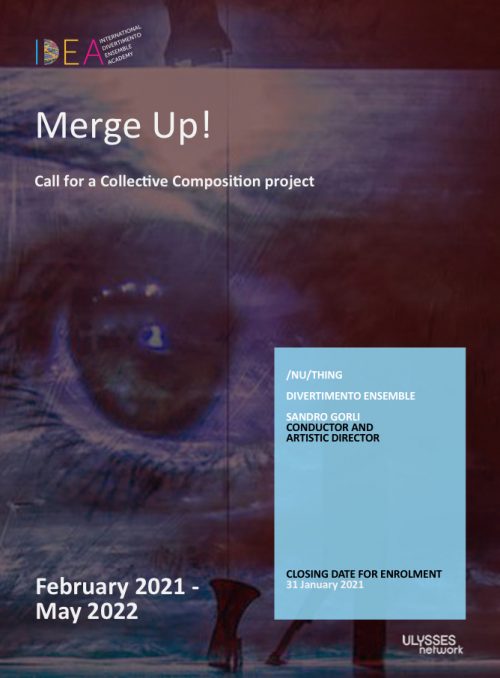
Common in many expressive forms, the custom of collective artistic creation is however extremely rare in the context of contemporary music composition. For this reason, Divertimento Ensemble, with the support of the European network ULYSSES, is launching an international call aimed at composers and artists who wish to experience this production method, as well as at existing collectives. The call is intended to foster the collective creation of a new musical or multimedia production by a group that is already formed, or which is set up for the occasion. The Italian collective of composers /nu/thing is participating in the project as a tutor, assisting the artists involved in their work of writing/conception.
Following an international call for applications, three young artists have been selected to participate in a collaborative project:Mathieu Corajod (French/Swiss based in Switzerland),
Giulia Lorusso (Italian based in France), a former ULYSSES Journey composer (2019)
Giovanni Montiani (Italian based in Italy).
A first work meeting takes place online during March 21, to launch the process and discuss the ideas of collective composition, methodology, risks, organisation in general, etc.
The work-flow is now ongoing and the project will be presented in September 2021.
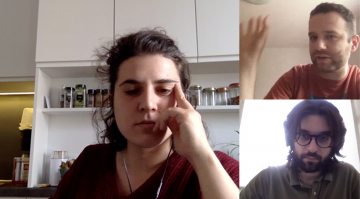
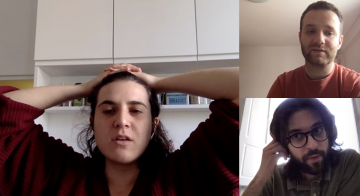
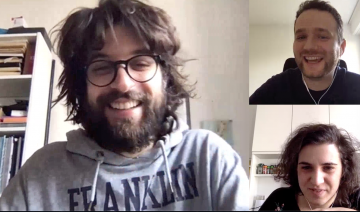
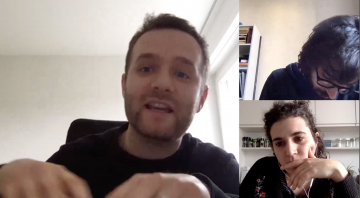
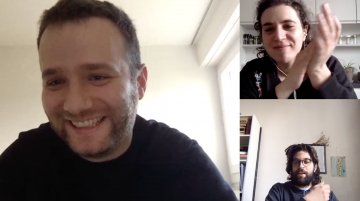
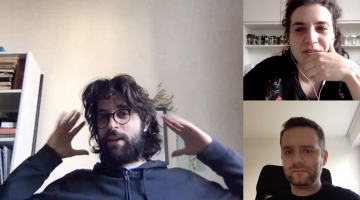
Further information here.
On Wednesday 9.3.22 at the IRCAM Forum Vertigo « Connecter les mondes », the group presented the project during the round table “création collaborative”.
What’s on :
Giulia Lorusso
10-14-2022
Collective composition: how it worked for us
We know that at the base of any creative process there is an indefinable number of stimuli and personal necessities. Likewise, our collective composition work started well before the score… We have discussed for a long time sharing our interests and our personal research to come to formulate a common starting idea. Our voices met around the desire to imagine an innovative context for listening which would put the listener's role into play with respect to the musicians. Hence the idea of spatialise the musicians in the space of the Fabbrica del Vapore with a walking audience equipped with bone-conduction headphones through which to listen to the electronics. This phase lasted from December 2020 to June 2021.
As this idea took shape down to the smallest detail, each of us began to put together in the form of sketches the first emerging musical ideas. We wanted to share these sketches from the very beginning and very spontaneously those ones began to circulate among us: we appropriated each other's material and the individual authorship of each idea faded into a truly collective process. We are convinced that it has taken us further than we would have gone individually. This phase lasted from July 2021 to December 2021
Towards the end did each one take the responsibility of completing one or more sections born from a constant collective exchange. This last part of the work did not prevent the confrontation between the three of us and, at times, the ideas of the group took precedence over the direction chosen by the individual responsible for each section.
This phase lasted from December 2021 to May 2022.
The collective work also ensured that the same musical idea circulated in several sections and was developed and re-interpreted by each one of us according to their own sensibility, giving life to resumptions and variations of cells, harmonies and musical gestures that cross the entirety of the piece. In particular transitions represented “pivotal” musical moments where the collective composition finds the place for an intense exchange between composers.
Giovanni Montiani
10-7-2022
Something more about Dorico
We want to spend some more words on the notation software that we used to realize this project, focusing on some features especially interesting for collective composition.
Working from a distance, we immediately sought solutions and strategies to facilitate the exchange, listening and understanding of ideas and proposals, of the music material developed. Dorico has been useful in this, allowing us to listen to each other complex harmonies, a simulation of the work done, making the exchange of material and the creative process more agile. With Dorico you can create custom tonal systems, which can present any number of octave divisions and contain all the necessary alterations and custom tone indications. For our project, we have created a tonal system with 48 divisions per octave (photo). The playback system also allows you to load new VST and MIDI musical instruments.
Another very important need in distance collaboration is the possibility of giving suggestions on what was composed by someone else quickly and intervening easily in writing. The possibility of leaving comments in the margin of the score offered by Dorico, allowed us to write considerations, notes, and suggestions, on a precise point of the composition, making its communication more immediate.
The use of streams, separate portions of music completely independent from the point of view of the musical context, allowed us to realize different developments of the same material, within a single project, while allowing us to modify the work of others without dispersing it.
Mathieu Corajod
10-5-2022
Parameters of spatial composition
Composing a hybrid form of concert and installation incorporating spatialized instruments in multiple physical locations creates new compositional challenges. The following parameters were used in the conception of the work, after being tested at the February 2022 reading session:
1.
Playing on all degrees between, on the one hand, music that fills the space and creates a continuum between locations (e.g. a chord made of sustained, resonant or repeated notes) and, on the other hand, music made of very distinct sources (e.g. staccato notes of different instruments in different locations)
2.
Work on synchronicity (homorhythmic events that can be heard as coming from different spatial sources) and the movement of sound (structures that make the sound move from one instrument to another, from one place to another)
3.
To make the music evolve between different levels of musical hierarchy and balance in relation to the distance between instruments.
For example, the first part of the work takes place mainly outside, so we chose percussive sounds for the piano and double bass, which can be heard very well, despite the fact that they are spatialised inside the building.
Second example: in the second part of the work, which takes place mainly indoors, the trumpet and trombone can still be heard very softly through the windows of the first floor.
Third example: the bass clarinet is almost isolated from the other instruments, but it communicates with the saxophone and thus forms a kind of duet, which is itself connected to the music as a whole.
From this perspective, many of the principles of orchestration and balance between the instruments no longer apply here. The listener is free to approach an instrument playing pianissimo without this sound being masked by another instrument playing louder. This new way of interacting makes it possible to compose by combining elements that are likely to be more heterogeneous than usual. As the instruments are not amplified, the listener is invited to come closer to hear certain passages better: the percussion which is hidden at the beginning of the work, the sounds of air noise which are only audible by coming closer. By changing the listening perspective, the threshold of perception of musical phenomena is redefined for each listener.
4.
Furthermore, the repetition or arrangement of the same musical material finds a new interest in a new spatial configuration. This is the case of part "C" (mainly outside) being arranged differently in a part of "I" (mainly inside).
5.
In terms of electronics, the use of bone conduction headphones allows to listen to a virtual musical space in addition to the surrounding sound environment. Depending on the nature of the sounds diffused in bone conduction headphones, the differences between close, intimate listening and listening to a distant source can be blurred. A "trompe-l'oreille" confusion arises between the different sound sources and the two superimposed listening modes. Furthermore, with individual headphones the electronic sounds move with the listener, whereas usually it is the electronics that are spatialized around a stationary audience.
These parameters guided us during the composition, without falling into a form of demonstration. In our opinion, the score is rich enough to be 'self-sufficient' (for radio listening, for example) but it is the spatialization of the instruments that gives the work its true dimension. This is why the work in concert should be represented in spatialized form. Although the creation has been optimized for the spaces of the Divertimento Ensemble at La Fabbrica del Vapore, it is not an in situ work that can only be performed in this space. Taking into consideration the original spatialization and the compositional ideas that have resulted from it (the most obvious example would be that of the bass clarinet, almost isolated), it is possible to imagine new performances in other places such as a museum, an industrial space, a performance or concert venue with several rooms and foyer, etc. For this reason, we did not play with parameters that were too specific to the creation space (resonance frequencies of the rooms, percussion on the architecture, etc.).
Giulia Lorusso
5-30-2022
Drawing the space for our project
The music is structured in two parts, corresponding to two spatialization configurations of the instruments. Starting from these two basic configurations, the musicians will also be able to move from time to time.
The first part begins outside, in the courtyard of the Fabbrica del Vapore. A wind quintet (clarinet, oboe, saxophone, trumpet, trombone) is placed all around the public in different places of the courtyard and at the entrances of the building. The sounds of the other instruments inside the building (piano, double bass, percussion) reach the audience as a second, more distant layer of sound.
In the second part, saxophone, clarinet and oboe enter the Fabrica del Vapore and are dispersed in several rooms. Only trumpet and trombone remain outside. The focus is on the interior of the building, while the trumpet and trombone provide a kind of distant echo in the music (although an audience member may choose to remain outside and perceive reversed relationships). An instrument like the saxophone, placed in the highly resonant staircase, can make the music communicate from one room to another.
Giovanni Montiani
4-26-2022
Why do we need a common music notation software? Why did we choose Dorico?
Composing collectively without a common writing tool would have imposed too many limits on our exchanges. We want to make modifications to each other's work, to take up, use and develop the material sketched out by another member of the group, to superimpose and combine the ideas of one person with those of the other. We also needed a common medium to give unity to our score. This need to exchange and to work on the basis of the same software is part of our desire to find a specific musical language for our collective composition project.
The three composers that we are have very different experiences with several music notation software. Choosing a common tool was therefore a significant challenge, which could have been a source of divergence within the group. We finally chose to work with Steinberg's Dorico software. On the one hand, it is obvious that it is particularly appropriate for contemporary music notation, and on the other hand, we had noticed several interesting features of Dorico that intrigued us, especially in a collaborative perspective (the “flows” for example, we will come back to that). Thus, to compose collectively and work remotely from different locations, we made Dorico our computer tool and our creative partner.
Mathieu Corajod
4-26-2022
Framing the project: a free exploration of an augmented musical space
The collective approach of this project led us to put the theme of relationship at the heart of our project. After reflecting on the relationships within our group of composers, we quickly wanted to create a new form of relationship with the public. It is this form of concert-installation, giving the audience an important role, that we will describe in this article.
The future composition offers an immersive and free setting to the audience. The audience enters several rooms that they can explore at will throughout the 40-minute composition performed by 8 musicians. The musicians are spatially positioned in different places and synchronized with each other by the Polytempo software, allowing them to play together while being far from each other. Each member of the audience is also given bone conduction headphones (headphones that leave the ear open), allowing him or her to live an augmented reality experience: the sounds of the electronics diffused by the bone conduction headphones are superimposed on the real instruments. These headphones have the particularity of not obstructing the external ear. As a result, the sounds in the headphones and the outside sounds - those of the instruments and the environment - blend together perfectly, providing an augmented reality experience. The soundtrack and real-time effects played in all the headphones should therefore be related to the instrumental parts played in all the rooms, giving a unity, a collective basis to the individualized experience of the concert-installation.
Any concert is a subjective experience for each member of the audience, but the particularity of this composition consists in the fact that the audience is obliged to make choices concerning the instruments that its members will hear in the foreground according to its position in the space. This choice obligation individualizes the concert experience. The synchronization of all the musicians despite the great distance between them from one room to another should create a captivating sensation of continuity and tutti in the space. The continuity and the musical coherence will be further reinforced by the sounds diffused by bone conduction headphones uniformly in the space. The concert device used here, combining new technologies (bone conduction headphones, Polytempo software) offers an original experience to the contemporary music audience for which we must find innovative compositional strategies.
The Polytempo software developed at the ICST in Zürich (Institute for Computer Music and Sound Technology), allows to compose complex tempo relationships between instrumentalists and to make them play music that would be unplayable without the help of technology. Moreover, the software lends itself perfectly to a synchronization between spatialized musicians in several places in the space. This setup allows the audience to experience an innovative music: audience members hear independent musical lines, spatialized in several communicating rooms, whose vertical counterpoint is provided by the Polytempo software. The music follows a horizontal dramaturgy going from A to B, leaving no room for chance in the relationships between the different instruments, but the audience is invited to find its own way inside the music, physically, by walking in the space. This freedom of wandering, placing the work halfway between concert and installation and giving a preponderant role to the perception of the public, questions the classical notion of work.
These ideas of exploration of a musical space by the listener and of augmented reality come from our previous individual experiences (virtual spatial installation, bone conduction headphones, other concert-installations) which have found a new collective form here by sharing with each other.
Giulia Lorusso
3-12-2022
On Wednesday 9.3.22 at the IRCAM Forum Vertigo « Connecter les mondes », we presented our project during the round table “création collaborative”. Here is the video of the speech: https://youtu.be/_H9pvZ8XtDI?t=4502
Giovanni Montiani
2-24-2022
Three composers, three times less or three times more work?
Why did we stop at three, and not four or five composers? Wouldn't we be more efficient with five people involved? We were tempted by this reasoning to expand the team, but it seemed more advisable to limit ourselves to three people for reasons we will explain here. We wanted to avoid writing a collective work that would have been simply a juxtaposition of several individually composed parts. We wanted to exchange at each stage of creation, to share our sketches, to respond to the proposals of others. A team of 4 or 5 composers could have made this process more complicated to set up, not least because of the coordination of a larger number of agendas to fix regular meetings...
The question remains whether collective composition takes more or less time than individual composition. Spontaneously, one might think that the work will be done more quickly. In our experience, as in that of the /nu/thing collective, this view seems to be erroneous, since all the stages of creation must be discussed as a group, references must be shared and explained, and finally, the decisions taken must not be the result of more or less frustrating or satisfying compromises, but must have a clear adhesion for the group. Would collective creation then take longer than individual composition? The /nu/thing collective suggested this to us, perhaps as a simple warning that we should not underestimate the work involved. For us, we think it really depends on the collective, the type of work envisaged, the trust within the team. In our group, the exchanges have so far been sufficiently fluid and a certain division of tasks has been able to compensate for the many extra hours needed for collective composition.
Giulia Lorusso
2-14-2022
Creativity is always collective, collaboration accentuates the benefits.
Creativity is a collective phenomenon: what we generally call “creative” is not the result of an individual activity but rather the product of several forces that occur together. By working on this project we are willing to use collaboration to directly accentuate the qualities and benefits of collective processes: dealing with complex problems, merging together different skills, methods, practices and knowledge.
Our group was formed especially for this project, as we already mentioned, on the basis of mutual esteem for each other's artistic works. We consider this to be a condition for the cohesion of the group and of the work, but also a factor that guarantees motivation for the project, whose humanly and artistically enriching dimension is moreover particularly motivating. Collective composition promotes for us the ideals of empathy and debate as fundamental for successful human and artistic interactions, by offering an ethic of creativity based on cooperation instead of prevarication of the others and competitivity. Dialogue, confrontation and acceptance of the other are important processes of the communication within our group.
Mathieu Corajod
1-29-2022
Hello!
Our names are Giovanni, Giulia and Mathieu, we are a collective of composers called CUE Creative/Union/Experience and we are looking forward to your visit on our blog to show you the behind-the-scenes process of a collective composition!
The Divertimento Ensemble's “Merge up!” call for projects attracted us by the originality of the suggested collective approach. We were curious to learn more thanks to the mentoring of the /nu/thing collective as well as by putting our hands to work ourselves. Driven by the desire to learn from others, to pool our resources and ideas, to create new music that none of us would have thought of individually, our collective was formed specifically for this call for projects. Our paths had crossed briefly during musical encounters (at the Livorno Music Festival and at Ircam), but it was not so much our previous personal contacts as our aesthetic tastes and our mutual esteem that guided us in the formation of our collective. Giovanni took the initiative of contacting Mathieu first, then Giulia, with whom a horizontal working structure was established from the very first exchanges.
As the call for projects was open to multidisciplinary creations, we considered asking visual artists or video artists to participate. However, we preferred to avoid the collective dimension focusing too much on the relationship between artists from different disciplines, as is the case for example in an opera production. It seemed to us more original in this project to focus on the relationship between three composers to create a new musical work.
Merge Up! is a project organized by Divertimento Ensemble, in the framework of the «Collaboratory » activity of the ULYSSES Network.
Co-funded by the Creative Europe Programme of the European Union
Tutor: /nu/thing
Technical partners: Dorico, Mezzoforte, ICST – Philippe Kocher.
With the support of Aargauer Kuratorium, Fondation Nicati-de Luze, the Swiss Arts Council Pro Helvetia (supporting Mr Corajod).
We thank them warmly for their support.